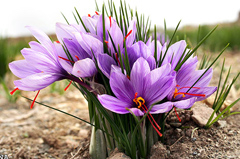Saffron Crocus is a bulb that produces the stamens that, when cut and harvested, produce the most expensive spice in the world, Saffron. This bulb is grown in great quantities in the Middle East and India along with many other countries. My bulbs come from The Netherlands.
The bulbs start to sprout after about a month or two but are still viable for a long time and can be planted through the winter and into the spring for bloom in the following fall.
Depth
Plant the bulbs with the point up about 3″ deep and water well. They can be 2″ apart or 6″ apart depending on how long you plan to leave them in the ground before dividing and replanting as they will make clumps of bulbs.
The clumps will grow over time:
They can be planted in larger clumps a little farther apart to make these patterns:
 Each corm develops young offsets and these will eventually produce more flowers in the clump. They can be divided by separating the offsets from the “mother corms” and planted with more space in between depending on how much area you have to plant and how patient you are!
Each corm develops young offsets and these will eventually produce more flowers in the clump. They can be divided by separating the offsets from the “mother corms” and planted with more space in between depending on how much area you have to plant and how patient you are!
As the blooms appear, the orange-red stamens can be clipped and set aside to dry for cooking. They will flavor a number of dishes from eggs to stews to warm drinks depending on your culture and tastes. Or you can accumulate enough to sell them for $5000 a pound anywhere in the world.
The blossoms should be harvested immediately and as they bloom at ground level do not make the best landscaping additions. But they can be planted in edgings and in wine barrels or in pots or in window boxes etc.
Plant corms at a density of 10 per square foot or simply dot them around a garden bed. Saffron flowers bloom first, often in mid-October. Next come the grassy leaves that remain green through the winter and should be cut back in spring when it turns brown or else corms won’t store enough energy for a the following fall bloom.
 Growing your own saffron takes a little dedication, but it’s satisfying to raise. And the beautiful violet-blue flowers will continue to be a welcome treat even after the saffron has been snipped.
Growing your own saffron takes a little dedication, but it’s satisfying to raise. And the beautiful violet-blue flowers will continue to be a welcome treat even after the saffron has been snipped.
You must pick the flower before it fully opens or wilts. An open flower begins to spill pollen onto the stigma, which devalues the spice, and a wilted flower compromises quality. The reddist part of the stigma is the most desirable.
For recipes, you can find many interesting dishes by Googling “saffron”.





0 Comments